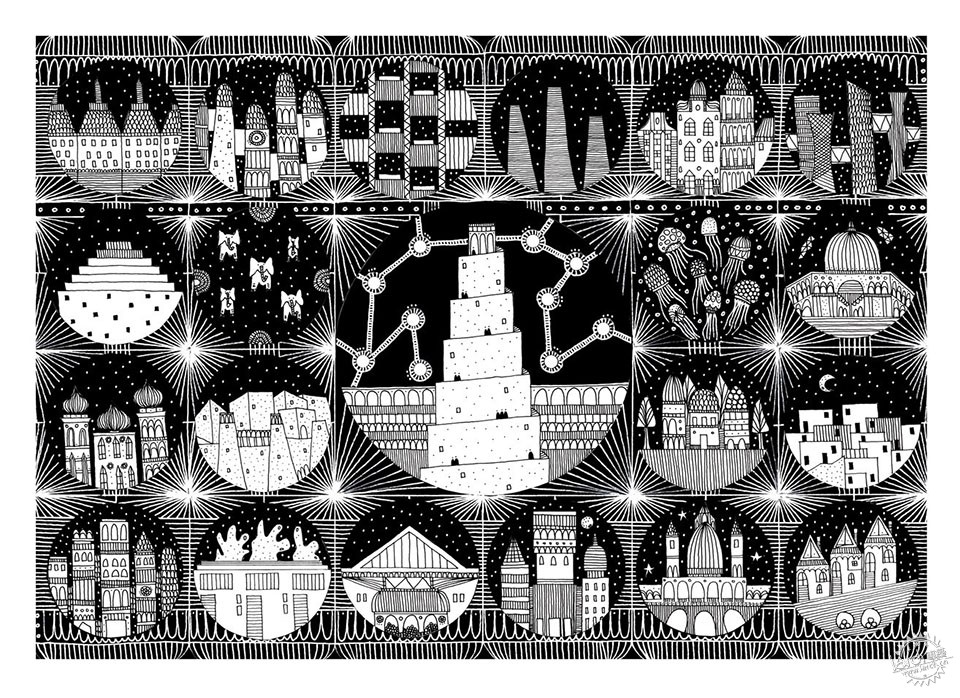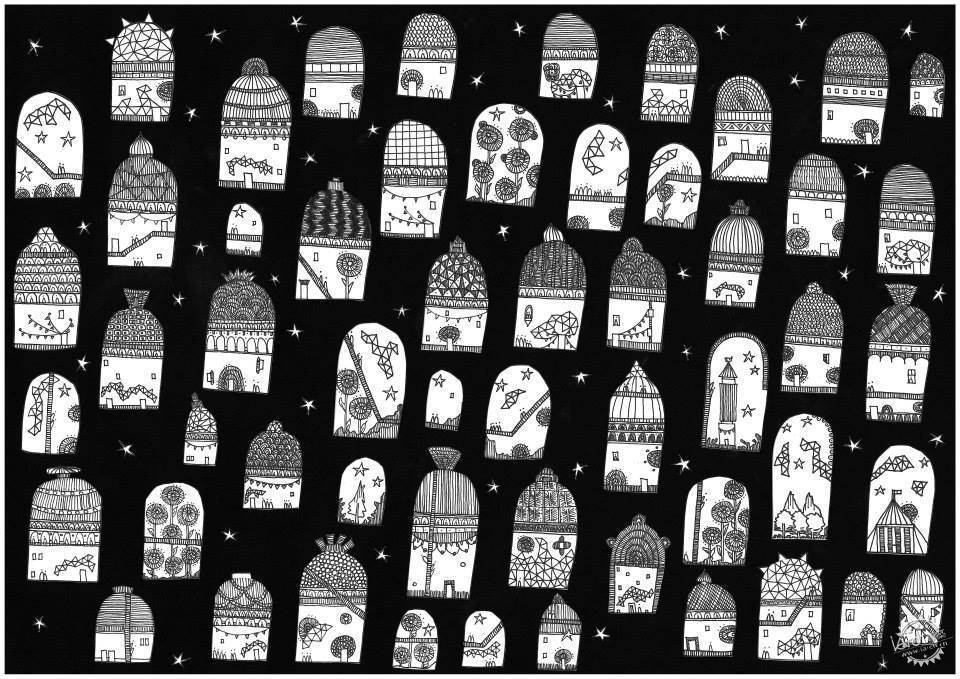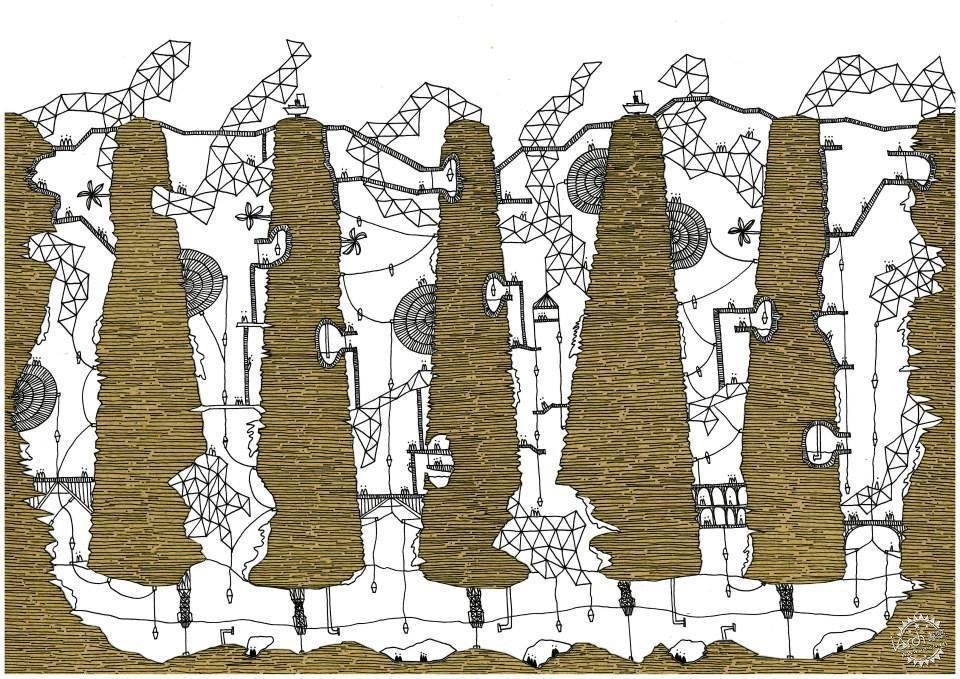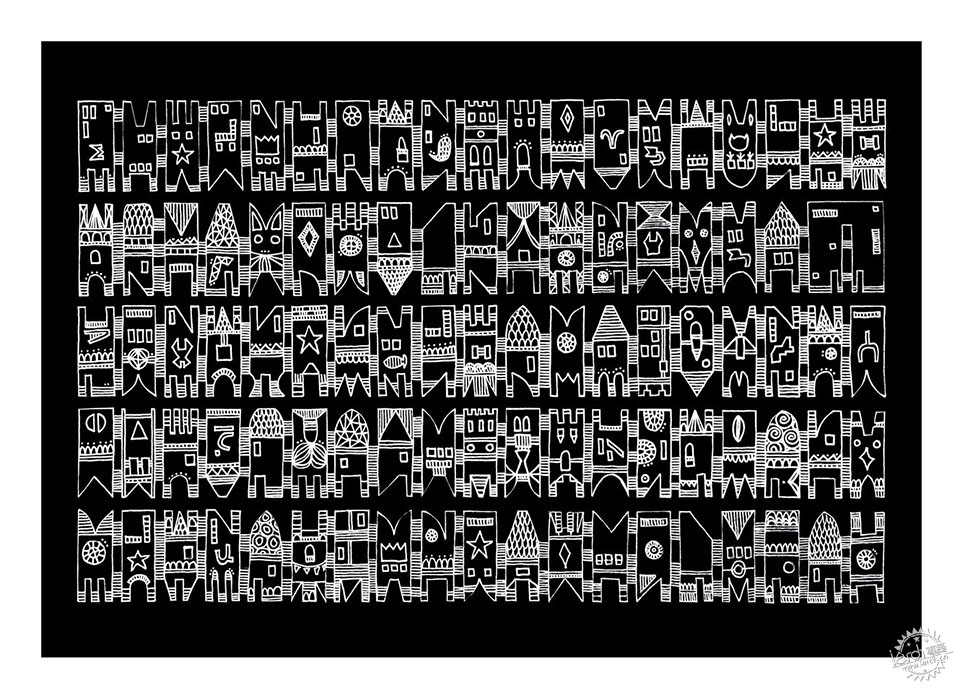
Fedora. Image © Karina Puente Frantzen
意大利作家卡尔维诺的《看不见的城市》中的三大建筑原则
Three Principles of Architecture as Revealed by Italo Calvino's 'Invisible Cities'
由专筑网李韧,杨帆编译
1972年意大利作家卡尔维诺的《看不见的城市》对我们许多人来说都并不陌生,书中生动的城市回忆、马可波罗对忽必烈的描述等细节都让人印象深刻。这本书并不是专门的传统建筑创作书籍,它对城市的介绍并不十分全面,而是提取部分精华为读者介绍了城市所包含的意义。
虽然书中对于细节的描述已经足够吸引读者,但《看不见的城市》真正的精华在于隐藏在这些细节中的时间、身份和语言等基本概念,这是马可和卡尔维诺巧妙地完成的一项壮举。因此,从书中可以总结出三条建筑原则。
Ah, Invisible Cities. For many of us, Italo Calvino’s 1972 novel reserves a dear place in our libraries, architectural or otherwise, for its vivid recollections of cities and their curiosities, courtesy of a certain Marco Polo as he narrates to Kublai Khan. And while the book doesn’t specifically fit the bill in terms of conventional architectural writing, it resists an overall categorisation at all, instead superseding the distillation of the cities it contains into distinct boundaries and purposes.
For though there is a certain kind of sensory appeal that is captured in the details of places, the real beauty of Invisible Cities lies in the masking of underlying notions of time, identity and language within these details – a feat that is skillfully accomplished by both Marco and Calvino. With this in mind, here are three of many such principles, as revealed by the layered narrative of Invisible Cities.

Diomira. Image © Karina Puente Frantzen
视觉特异性即文化语言
这本书的许多吸引人的部分都可以归结为是写作的特殊性。书中说明,55个不同版本的城市生活是迷人的性格描述,第一个是Diomira,书中描述为“这是一个拥有六十个银圆顶的城市,这里有众神的青铜雕像,街道上铺满了铅,还有一座水晶剧场,每天清晨的高塔上都有一只金色的公鸡”。这些细节构成了马可波罗和我们之间的整体视觉表达,我们将自己假设为忽必烈,通过对于类型与文物的描述,这有助于虚构城市的成功创建。这也表明我们对特定意象的内在依赖,从而产生了理解,这是建筑的重要组成部分。
“现在,Great Khan的账目是他所能想到最精确、最详细的文件了,毫无疑问的是,他们并不满足。然而,每个关于某个地方的信息都涌进皇帝的脑海里,这是马可指定地点的第一个手势或对象。”
然而,这种高度视觉文化的影响有时似乎并不容易被注意到。马可波罗描述了塔玛拉城,这里充满了各种各样的迹象,“眼睛虽然看不见事物,但事物的形象意味着其他内涵”,这说明我们目前过分依赖于独特的象征性交流,这样便减少了许多图像信息地传递,以及缺乏图像信息所包含的各种内涵。虽然建筑基本上凭借的是视野与媒介,但重要的是人们应当通过自己感官的体验与理解,从而产生无意识的进化。马可自身则是一种更为抽象的城市标识,仅仅通过语言也许并不能真正理解其中的特殊内涵。
“所以,每一个城市在被精确的语言描述了基本信息后,他也跟风无声地评论,举起他的手、手掌、手背,伸直或倾斜、抖动或缓慢。”
Visual Specificity As A Cultural Language
Much of Invisible Cities’ charm can be attributed to the specificity of its writing, and as a result, its narration. Throughout the narrative, 55 versions of city life are described with enthralling character, the first of which is Diomira, “a city with sixty silver domes, bronze statues of all the gods, streets paved with lead, a crystal theatre, a golden cock that crows each morning on the tower.” Details such as these constitute the overall visual communication between Marco Polo and us, as we assume the role of Kublai Khan, contributing to the successful creation of fictional cities through typologies and artifacts. This demonstrates our inherent reliance on specific imagery to create understanding; a facet that is an integral part of architecture.
“Now his accounts were the most precise and detailed that the Great Khan could wish and there was no question or curiosity which they did not satisfy. And yet each piece of information about a place recalled to the emperor’s mind that first gesture or object which Marco has designated the place.”
Yet, the impact of this highly visual culture seems to go unnoticed at times. Polo describes the city of Tamara, laden with signs of all sorts, where “the eye does not see things but images of things that mean other things.” This is telling of our current over reliance on distinct symbolic communication, and a reduction of the image to encompass certain connotations. Though architecture is fundamentally a visual field and medium, it is important to allow for an unintentional evolution of meaning and understanding through one’s own sensory experiences, as a result of a slightly passive hand of the architect. Marco himself resorts to a more abstract identification of cities, providing genuine translation not possible through the specificity of visual wordplay.
“So, for each city, after the fundamental information given in precise words, he followed up with a mute commentary, holding up his hands, palms out, or backs, or sideways, in straight or oblique movements, spasmodic or slow.”

Isaura. Image © Karina Puente Frantzen
建筑对于自然的依赖
正如马可描述的那样,大自然在许多城市的发展中起着至关重要的作用。举个例子,伊佐拉,被称为“千年之井”的城市临湖而建,在这里“居民通过挖垂直孔洞,将水引到城市”。水是生命之源,是每个建筑建成的必要驱动条件(在这种情况下,例如大坝),它也作为密切联系城市与人的枢纽。水的重要性进一步体现在人们共同的文化理解中,它既作为一种物质,也是一种建筑景观,是一种多样性元素。
“人们说,城市的神灵生活在地下溪流的黑湖中。人们也说,众神生活在井里,从缆绳上升起,悬挂在井的边缘。”
现在,我们对自然的定义比以前更加多样,我们与建筑同时在不断地改造自然。因此,全球环境的变化也在无形之中影响了建筑的功能,从而达到人与自然相互作用的和谐。对于这一理念,特科拉市的做法是通过不断地建设,从而“使破坏无法诞生”。当有人问,如果停止施工是否会导致城市崩溃,他们的回答是:“生活不只是城市”。很明显的是,许多固定的工作正在被大自然所影响,虽然这并不直接与全球变暖的威胁相关,但都来源于自然,都处在自然条件下,因此我们应当呼吁建筑遵守自然法则。
“除非能够建成一座城市,否则建设的目的是什么?你所遵循的计划,蓝图在哪里?我们会在工作日结束后向你展示我们的成果,他们这样回答。日出而作,日落而息,夜幕降临时,天空充满了星星。他们说,这就是蓝图。”
Architecture’s Reliance On Nature’s Omnipotence
Nature plays a key role in many of the cities that Marco describes, at times dictating with a certain omnipotence the very functioning of architecture and the behavior of its inhabitants. One example is that of Isaura, a “city of the thousand wells” built over a deep lake, where “the inhabitants dig long vertical holes in the ground and succeed in drawing up water, as far as the city extends.” Water, as a vitality of life, is a major driving force behind the formation of a necessary architectural typology (in this case, the dam) as well as the relationship between the city and its people. The importance of water is further embodied in the people’s shared cultural understanding; its importance both as a substance and in formulating a kind of landscape architecture, hold elements of the divine.
“The city’s gods, according to some people, live in the depths, in the black lake that feeds the underground streams. According to others, the gods live in the buckets that rise, suspended from a cable, as they appear over the edge of the wells…”
Now in the age of the Anthropocene, our definition of what constitutes as natural is more varied than before, given our drastic alteration of the natural world in which architecture itself is complicit. As a result, global environmental change will dictate architecture’s role more than ever, in order to mediate this and assume a coexistence with its landscape. This notion is apparent in the city of Thekla, which is constantly under construction “so that its destruction cannot begin”. When one asks if stopping the construction will cause the city to fall to pieces, the reply is: “not only the city.” Soon, it is made apparent that this constant work is being ordained by the cosmic order of the stars, and though this does not directly compare to the threats of global warming, both are natural conditions that call for an architecture to abide by them, to prevent Thekla’s demise.
“What is the aim of the city under construction unless it is a city? Where is the plan you are following, the blueprint? We will show it to you as soon as the working day is over… they answer. Work stops at sunset. Darkness falls over the building site. The sky is filled with stars. There is the blueprint, they say.”

Tamara. Image © Karina Puente Frantzen
城市的永垂不朽
在Laudomia,这个城市由三个方面组成——生活、死亡和未出生的孩子。随着生活城市人口的增长,人们的各项任务都服务于死亡,他们认为生活是为了“死亡,并且把自己的名字刻在石板上”或者是为“在不存在的空间里审问自己”。 这才是他们拥有的生活。这也是城市和建筑普遍存在的本质,在它到来之前呈现一种状态,同样,未来的状态也将取代它的位置。一个城市的个性是由过去和现在不断积累而决定,社会不断创造多个意识形态,同时已经存在的又成为了过去。一个城市所能留下的任何印记都是永恒的结果。
“Laudomia的生活是为了寻找死亡本身的意义,无论找到与否都有更多的风险:解释的原因甚至超过了城市自身,而不同的城市也许有不同的解释方式。”
另一方面,卡尔维诺最终认为所有的城市都起源于一个城市。就马可波罗的情况下,这个城市是他的家乡威尼斯,但总的想法是,所有的变化都是单个城市不同的表现形态,每样东西的不同表现“构建了欲望和恐惧,即使它们的表述十分隐秘,即使它们的规则十分荒谬,即使它们的观点不具说服力”。当忽必烈开始描述自己建造的城市时,马可回答说:“这正是我告诉你的内容”。因此暗指所有城市都来自于我们的集体无意识。
“每个城市都具备所有城市的共通点,有各自的地方交流形式、秩序、距离。每个城市都原封不动地保留着这些差异:就像名字里的不同字母一样。”
正如《看不见的城市》所表达的那样,这三个原则相互关联。城市的认同感与凝聚力最终通过我们的视觉特异性来表达与翻译,它由景观和自然限制所决定。我们这个时代的景观也取决于建筑的形成,这反过来又受到类型和视觉先例的影响。然而,卡尔维诺的真正价值在于,他为我们提供了一种探索建筑的方法,通过所展示的表面价值,让我们沉浸于未来与过去,以及面对现代文明。《看不见的城市》认同那些看上去一时难以接受甚至生硬的术语,因为等待黑暗来到,我们也可以在星空看到我们的蓝图。
文中插图由Karina Puente Frantzen创作
The Timelessness Of The City
In Laudomia, the city is composed of three identically named sides: that of the living, the dead, and the unborn. As the living city increases in population, so does the periphery of the tombs of the dead and the realm of the unborn, both of which serve the living as they “visit the dead and decipher their own names on their stone slabs” and “frequent the house of the unborn to interrogate them” on their own lives, not the ones yet to come. Such is the nature of the existence of cities and architecture in general; there is a form of the present that precedes its arrival and likewise, a future state that will take its place. A city’s identity is molded by both past and present, constantly creating multiple potential futures that simultaneously become possible pasts; the result is a sort of timelessness that a city can identify with.
“The living Laudomia has to seek in the Laudomia of the dead the explanation of itself, even at the risk of finding more there or less: explanations for more than one Laudomia, for different cities that could have been and were not.”
In another sense, Calvino ultimately argues that all cities stem from one. In the case of Marco Polo, that city is his native Venice, but the overall idea is that all variations are multiple faces of the singular city – a product of timeless constructs “made of desires or fears, even if the thread of their discourse is secret, their rules absurd, their perspectives deceitful.” When Kublai begins to describe his own constructed city, Marco replies: “This is precisely the city I was telling you about when you interrupted me,” thus alluding to the notion of interconnected identities that are shared by all cities and stem from our collective knowledge.
“Each city takes to resembling all cities, places exchange their form, order, distances, a shapeless dust cloud invades the continents. Your atlas preserves the differences intact: that assortment of qualities which are like the letters in a name.”
These three principles as expressed by Invisible Cities are interrelated themselves, as is the case in the book. The identity of a city is ultimately expressed and translated most frequently through our culture of visual specificity, and it is determined by the constraints of landscape and nature that envelope it. The landscape, in our current era, is now also determined by architecture’s imposition on it, which in turn is influenced by typological and visual precedents for form and function. Yet, the true value of Calvino is that he offers us a means of exploring architecture past what it presents at face value, inviting us to indulge in potentials of future histories and timeless past in the face of the inferno of modern civilization. Invisible Cities deems it acceptable to look past the blunt technicalities for a moment, and wait for darkness to fall, so we too can see our blueprint in the stars.
Illustrations created by Karina Puente Frantzen
出处:本文译自www.archdaily.com/,转载请注明出处。
|
|
